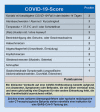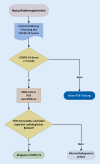[Risk stratification through implementation and evaluation of a COVID-19 score : A retrospective diagnostic study]
- PMID: 33156352
- PMCID: PMC7645898
- DOI: 10.1007/s00063-020-00754-4
[Risk stratification through implementation and evaluation of a COVID-19 score : A retrospective diagnostic study]
Abstract
Background: The clinical manifestation of COVID-19 is nonspecific and varies greatly, which makes it more difficult to discriminate from other (virus) infections. Neither individual findings nor combinations of findings are specific enough to be able to diagnose COVID-19 with a high degree of certainty. The goal was to identify patients in the emergency department, who are at risk for COVID-19 disease, early by using a score, so that they could be isolated pre-emptively.
Method: Development and implementation of a symptom-based COVID-19 score based on a multicentric retrospective evaluation in three German emergency departments from 9 March until 30 April 2020 of patients suspected of having COVID-19 and subsequent SARS-CoV‑2 PCR testing.
Results: The study population included 697 patients and 9.4% of these patients were diagnosed with COVID-19 infection. A COVID-19 score of ≥5 points was associated with a significantly increased likelihood of illness. The sensitivity of the score was 98.4% with a moderate specificity of 48.3%.
Discussion: The score, which is easy to obtain during the initial assessment, supports the assessment of the pretest probability for a COVID-19 infection as part of the risk stratification and can influence the treatment pathway in terms of pre-emptive isolation, PCR testing and other treatment options at an early stage. Due to the nonspecific symptoms of the disease; however, it must be accepted that the goal of high sensitivity results in a relatively low specificity of the score.
Zusammenfassung: HINTERGRUND: Die COVID-19-Erkrankung (Coronavirus Disease 2019) ist in ihrer klinischen Manifestation unspezifisch und sehr variabel, wodurch die Diskriminationsfähigkeit zu anderen (Virus‑)Infekten erschwert ist. Weder Einzelbefunde noch Befundkombinationen sind spezifisch genug, um eine COVID-19-Erkrankung mit hoher Sicherheit diagnostizieren zu können. Ziel war es, in der Notaufnahme durch Anwendung eines Scores frühzeitig Patienten identifizieren zu können, die ein Risiko für eine COVID-19-Erkrankung haben und somit präemptiv isoliert werden müssen.
Methode: Entwicklung und Implementierung eines symptombasierten COVID-19-Scores anhand einer multizentrischen retrospektiven Diagnostikstudie in 3 deutschen Notaufnahmen vom 09.03. bis 30.04.2020 an Patienten mit Verdacht auf COVID-19 und anschließender SARS-CoV-2-PCR-Diagnostik.
Ergebnisse: Das Studienkollektiv umfasste 697 Patienten, bei 9,4 % dieser Patienten wurde eine COVID-19-Infektion diagnostiziert. Ein COVID-19-Score ≥5 Punkte ging mit einer deutlich erhöhten Erkrankungswahrscheinlichkeit einher. Die Sensitivität des Scores lag bei 98,4 % bei einer allerdings mäßigen Spezifität von 48,3 %.
Schlussfolgerung: Der während der Ersteinschätzung einfach zu erhebende Score unterstützt im Rahmen der Risikostratifizierung die Beurteilung der Vortestwahrscheinlichkeit für eine COVID-19-Infektion und kann frühzeitig den Behandlungspfad bezüglich präemptiver Isolation, PCR-Testung und weiterer Behandlungsoptionen beeinflussen. Aufgrund der unspezifischen Symptomatik der Erkrankung muss allerdings in Kauf genommen werden, dass für das Ziel einer hohen Sensitivität eine relativ geringe Spezifität des Scores resultiert.
Keywords: COVID-19; Emergency department; Emergency medicine; SARS-CoV‑2; Score.
References
-
- European Centre for Disease Prevention and Control (2020) Rapid risk assessment: coronavirus disease 2019 (COVID-19) in the EU/EEA and the UK—ninth update. http://www.ecdc.europa.eu/sites/default/files/documents/covid-19-rapid-r.... Zugegriffen: 5. Mai 2020
-
- Gemeinsamer Bundesausschuss (2020) ESEG – Erkennung und Steuerung epidemischer Gefahrenlagen. https://innovationsfonds.g-ba.de/projekte/versorgungsforschung/eseg-erke.... Zugegriffen: 5. Mai 2020 (https://www.rki.de/DE/Content/Infekt/Ausbrueche/ESEG/ESEG_node.html)
MeSH terms
LinkOut - more resources
Full Text Sources
Medical
Miscellaneous




